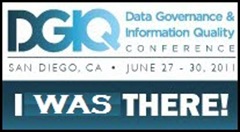Data Governance and Information Quality 2011
/Last week, I attended the Data Governance and Information Quality 2011 Conference, which was held June 27-30 in San Diego, California at the Catamaran Resort Hotel and Spa.
In this blog post, I summarize a few of the key points from some of the sessions I attended. I used Twitter to help me collect my notes, and you can access the complete archive of my conference tweets on Twapper Keeper.
Assessing Data Quality Maturity
In his pre-conference tutorial, David Loshin, author of the book The Practitioner’s Guide to Data Quality Improvement, described five stages comprising a continuous cycle of data quality improvement:
- Identify and measure how poor data quality impedes business objectives
- Define business-related data quality rules and performance targets
- Design data quality improvement processes that remediate business process flaws
- Implement data quality improvement methods
- Monitor data quality against targets
Getting Started with Data Governance
Oliver Claude from Informatica provided some tips for making data governance a reality:
- Data Governance requires acknowledging People, Process, and Technology are interlinked
- You need to embed your data governance policies into your operational business processes
- Data Governance must be Business-Centric, Technology-Enabled, and Business/IT Aligned
Data Profiling: An Information Quality Fundamental
Danette McGilvray, author of the book Executing Data Quality Projects, shared some of her data quality insights:
- Although the right technology is essential, data quality is more than just technology
- Believing tools cause good data quality is like believing X-Ray machines cause good health
- Data Profiling is like CSI — Investigating the Poor Data Quality Crime Scene
Building Data Governance and Instilling Data Quality
In the opening keynote address, Dan Hartley of ConAgra Foods shared his data governance and data quality experiences:
- It is important to realize that data governance is a journey, not a destination
- One of the commonly overlooked costs of data governance is the cost of inaction
- Data governance must follow a business-aligned and business-value-driven approach
- Data governance is as much about change management as it is anything else
- Data governance controls must be carefully balanced so they don’t disrupt business processes
- Common Data Governance Challenge: Balancing Data Quality and Speed (i.e., Business Agility)
- Common Data Governance Challenge: Picking up Fumbles — Balls dropped between vertical organizational silos
- Bad business processes cause poor data quality
- Better Data Quality = A Better Bottom Line
- One of the most important aspects of Data Governance and Data Quality — Wave the Flag of Success
Practical Data Governance
Winston Chen from Kalido discussed some aspects of delivering tangible value with data governance:
- Data governance is the business process of defining, implementing, and enforcing data policies
- Every business process can be improved by feeding it better data
- Data Governance is the Horse, not the Cart, i.e., Data Governance drives MDM and Data Quality
- Data Governance needs to balance Data Silos (Local Authority) and Data Cathedrals (Central Control)
The Future of Data Governance and Data Quality
The closing keynote panel, moderated by Danette McGilvray, included the following insights:
- David Plotkin: “It is not about Data, Process, or Technology — It is about People”
- John Talburt: “For every byte of Data, we need 1,000 bytes of Metadata to go along with it”
- C. Lwanga Yonke: “One of the most essential skills is the ability to lead change”
- John Talburt: “We need to be focused on business-value-based data governance and data quality”
- C. Lwanga Yonke: “We must be multilingual: Speak Data/Information, Business, and Technology”
Organizing for Data Quality
In his post-conference tutorial, Tom Redman, author of the book Data Driven, described ten habits of those with the best data:
- Focus on the most important needs of the most important customers
- Apply relentless attention to process
- Manage all critical sources of data, including external suppliers
- Measure data quality at the source and in business terms
- Employ controls at all levels to halt simple errors and establish a basis for moving forward
- Develop a knack for continuous improvement
- Set and achieve aggressive targets for improvement
- Formalize management accountabilities for data
- Lead the effort using a broad, senior group
- Recognize that the hard data quality issues are soft and actively manage the needed cultural changes
Tweeps Out at the Ball Game
As I mentioned earlier, I used Twitter to help me collect my notes, and you can access the complete archive of my conference tweets on Twapper Keeper.
But I wasn’t the only data governance and data quality tweep at the conference. Steve Sarsfield, April Reeve, and Joe Dos Santos were also attending and tweeting.
However, on Tuesday night, we decided to take a timeout from tweeting, and instead became Tweeps out at the Ball Game by attending the San Diego Padres and Kansas Royals baseball game at PETCO Park.
We sang Take Me Out to the Ball Game, bought some peanuts and Cracker Jack, and root, root, rooted for the home team, which apparently worked since Padres closer Heath Bell got one, two, three strikes, you’re out on Royals third baseman Wilson Betemit, and the San Diego Padres won the game by a final score of 4-2.
So just like at the Data Governance and Information Quality 2011 Conference, a good time was had by all. See you next year!
Related Posts
Stuck in the Middle with Data Governance
DQ-BE: Invitation to Duplication
TDWI World Conference Orlando 2010
Light Bulb Moments at DataFlux IDEAS 2010
TDWI World Conference Chicago 2009




